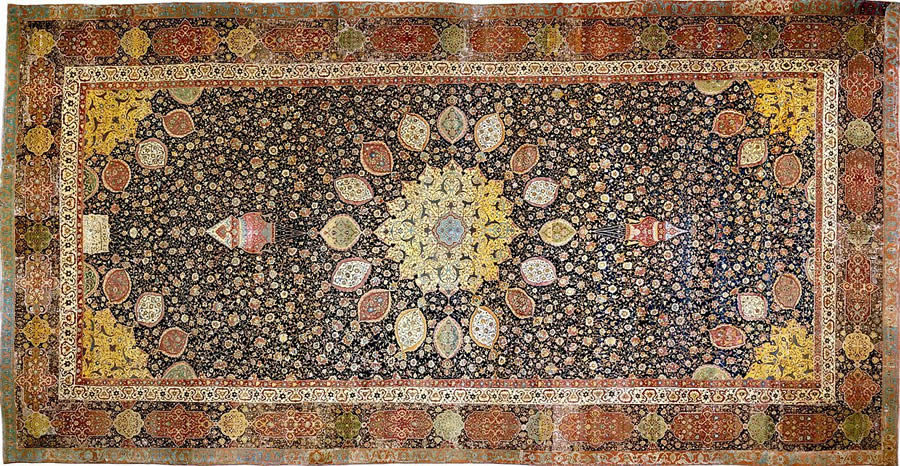7.1 Materials, Processes, & Techniques in West & Central Asia
3 min read•june 18, 2024
Ariella Ramjohn
AP Art History 🖼
34 resourcesSee Units
Style & Art Forms
Art can be maneuvered in many forms across a variety of cultures. The different techniques, materials, and processes used to create these historical pieces are influenced by culture and, thus, location.
The general style of art from West and Central Asia tends to follow two-dimensional designs. The works are typically decorative as they emphasize geometric forms, vegetal designs, and organic forms. Figural works utilize art forms to highlight varied perspectives as well as patterned landscapes. Forms of art in West and Central Asia include calligraphy, metalwork, ceramics, painting, and textiles.
Metalwork
The creation of decorative objects (including sculptures, vessels, armor and tack, metal plaques, and arms) commenced the flourishing of metallurgy and metalwork in West and Central Asia. Many historians tend to recall Islamic metalwork as an exquisite decorative art form during the medieval era.
Metal sculptures in particular were an imperative art form in Himalayan Buddhist art, in addition to Central Asian art. The Buddhist figures were ornamented with metal inlay, gilding, and paint as they were crafted with brass, bronze, silver, and copper. The processes used to create these metal artworks involved inlaying, casting, embossing, chasing, and beating.
Ceramics
Ceramic arts in particular were popularized in West Asia since the prehistoric era. Many of the technical advancements involved, such as the cobalt-on-white slip painting and lusterware, originated from the development of ceramic arts. The main uses of this art form was to create utilitarian vessels as well as expand on architectural decoration (specifically, ceramic arts were paired with painted and mosaic-tiled decoration for architectural purposes).
Persian mosaic-tile architecture, in which came from the Seljuk and Safavid dynasties and can be seen in the Great Mosque of Isfahan, is one example of West and Central Asian ceramics. Other examples include export ceramics as well as the Iznik-tile work, which was commonly crafted by the Ottoman dynasty.
Calligraphy, Painting, & Textiles
Calligraphy, mostly found in Islamic art, was one of the most prominent art forms in West and Central Asia. Calligraphy was used to record sacred texts as it can be found on architecture, ceramic tiles, decorative art objects, and manuscripts (which were written on cloth, vellum, or paper).
Painting in West and Central Asia was utilized in three different forms- including manuscript painting and wall painting. The other form was mainly found in the Himalayan regions and was known as the painting of thangkas (or immensely sized paintings on cloth). This type of painting mostly captured Buddhist deities as well as mandalas.
Textile forms from West and Central Asia include those of silk: silk velvets, silk and wool carpets, and silk-tapestry weaving.
Important Works in West & Central Asia
188. Basin (Baptistère de St. Louis)
- Muhammad ibn al–Zain
- 1320–1340 C.E.
- Brass inlaid with gold & silver

189. Bahram Gur Fights the Karg
- Folio from the Great Il–Khanid Shahnama
- Islamic: Persian, Il’Khanid
- 1330–1340 C.E
- Ink & opaque watercolor, silver, and gold (on paper)

191. The Ardabil Carpet
- Maqsud of Kashan
- 1539–1540 C.E.
- Wool & silk

Browse Study Guides By Unit
🗿Unit 1 – Global Prehistoric Art, 30,000-500 BCE
🏛Unit 2 – Ancient Mediterranean Art, 3500-300 BCE
⛪️Unit 3 – Early European and Colonial American Art, 200-1750 CE
⚔️Unit 4 – Later European and American Art, 1750-1980 CE
🌽Unit 5 – Indigenous American Art, 1000 BCE-1980 CE
⚱️Unit 6 – African Art, 1100-1980 CE
🕌Unit 7 – West and Central Asian Art, 500 BCE-1980 CE
🛕Unit 8 – South, East, and Southeast Asian Art, 300 BCE-1980 CE
🐚Unit 9: The Pacific, 700–1980 ce
🏢Unit 10 – Global Contemporary Art, 1980 CE to Present
📚Study Tools

Fiveable
Resources
© 2025 Fiveable Inc. All rights reserved.